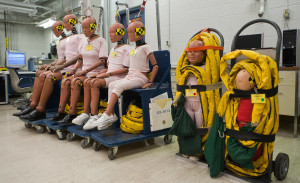Crash test dummies are very important media for automotive crash testing and are considered the rear life savers since the chances of a certain car model to be more road-worthy or safe rely on these test devices.
The dummies mimic the weight proportions, dimensions as well as the articulation of a human body. They are instruments used to gather data regarding the dummy’s dynamic behavior while simulating vehicle impacts or collisions.
The data collected from the used crash test dummies include the crushing force generating during the impact, impact velocity, body torque, bending direction, folding action as well as deceleration values during the collision.
Alderson’s crash test dummies
Crash test dummies have been used since 1949. In 1950, a dummy was created by Samuel W. Alderson of the Alderson Research Labs and was used to perform crash tests for both aircraft and motor vehicles.
Alderson also created the VIP-50 series dummy for crash testing operations performed by Ford and General Motors.
GM Motors combined the capabilities of the VIP series by Alderson and the Sierra Stan dummy made by Sierra Engineering Co. to form a Hybrid 1 male dummy used for vehicle crash testing.
Kinds of crash test dummies
Crash test dummies are primarily used for studying the effects of frontal impacts on vehicle, and can also be used in assessing internal organ, rib and spine effects during side collisions.
- Side Impact Dummy. Data such as spine and rib deceleration as well as those resulting from compression of chest cavity can be obtained from a side impact dummy.
- Rear Impact Dummy. This is designed to provide information with regards to whiplash and also helps designers in designing reliable head and neck restraining devices.
- Child dummy. This dummy is used to test the reliable of child restraining devices such as airbags and seat belts.
- Facial Impact Dummy. An advanced dummy called Thor has a more human like pelvis and spine while its face has multiple face sensors that reliably help in evaluating facial impacts at a high level.
How crash test dummies work
A full scale anthropomorphic test device is first subjected to calibration before being set up for a crash test.
The dummy is placed inside the test vehicle and secured to a seating position prior to marking on either the head and the knees. Most dummies have a leather skin while the dummy knees are installed with metal probe for checking proper puncture. About 50 data channels are usually installed from the head to the ankle of the dummy so as to be capable of recording of up to 30000 data items for each 100 to 150 millisecond crash. The data are initially stored in the data repository at the chest of the dummy. The collected data are downloaded into computer after the crash test has been finalized.

